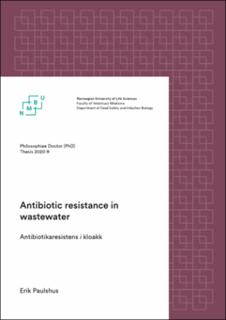| dc.contributor.advisor | Sørum, Henning | |
| dc.contributor.advisor | Bjelland, Ane Mohn | |
| dc.contributor.advisor | Kühn, Inger | |
| dc.contributor.advisor | Möllby, Roland | |
| dc.contributor.author | Paulshus, Erik | |
| dc.coverage.spatial | Norway | en_US |
| dc.date.accessioned | 2020-07-14T06:46:26Z | |
| dc.date.available | 2020-07-14T06:46:26Z | |
| dc.date.issued | 2020 | |
| dc.identifier.isbn | 978-82-575-1675-8 | |
| dc.identifier.issn | 1894-6402 | |
| dc.identifier.uri | https://hdl.handle.net/11250/2663905 | |
| dc.description.abstract | Antibiotic resistance is a characteristic possessed by some bacteria that enables them to
withstand the effects of antibiotic treatment. Antibiotic use and abuse may result in
development of antibiotic resistant bacteria. After an antibiotic treatment, antibiotics are
partially excreted in urine and feces, and wastewater is therefore an important source of
both bacteria and antibiotics from healthy and sick individuals. Due to the close contact
between large numbers of bacteria and diverse types of antibiotics over prolonged
periods, wastewater has the potential to select for and disseminate antibiotic resistance
into the environment. Previous studies of hospital wastewater effluents have shown that
these outlets discharge more antibiotic resistance factors than the general population.
This study was initiated to map the occurrence of antibiotic resistance in wastewater
under Norwegian conditions to identify whether local treatment of hospital wastewater
could contribute to limit the dissemination of antibiotic resistance to the environment.
Samples of untreated wastewater were collected monthly during one year from a
hospital, a community, and from the wastewater treatment plant that treats the
wastewater from the Greater Oslo region. The samples were analyzed for the occurrence
of antibiotic resistant E. coli, 53 different antibiotics, heavy metals, and 144 bacterial
genes encoding antibiotic resistance and mechanisms for the transfer of these genes
between bacteria.
During this study, higher levels of antibiotics and antibiotic resistant bacteria were
found in wastewater from the hospital than from the general population. Broad-spectrum
antibiotics were also present at much higher concentrations in the hospital effluents.
These results indicate that local treatment of the hospital wastewater system may help
limit the spread of resistance to the environment. A cost-benefit analysis should be
performed to determine whether localized hospital wastewater treatment may be more
effective than large-scale implementation at the wastewater treatment plants.
This study also identified variants of multi-resistant E. coli producing ESBL-enzymes
that can degrade broad-spectrum β-lactam antibiotics in the wastewater from the studied
community. Some of these bacteria were exclusively and repeatedly found in the
community wastewater. These belonged to two types of highly infectious E. coli (ST131
and ST648) that have been found all over the world. The finding of these bacterial
clones in the community wastewater indicates that the dissemination of multi-resistant
and pathogenic bacteria through wastewater is not exclusively attributable to hospital
effluents. Hence, it is recommended to investigate additional as well as other types of
outlets to identify potential high-risk sources for the spread of antibiotic resistance.
High abundances of genes encoding mechanisms for lateral transfer of antibiotic
resistance were found in this study, as well as clinically relevant antibiotic resistance
genes like ndm-1 that have only scarcely been reported in association with clinical
disease in Norway. These results thus verified a previous study of wastewater from
European countries, wherein Norway had the highest levels of lateral transfer genes.
Even though Norway has a relatively low prevalence of antibiotic resistance and a
moderate consumption of antibiotics due to strict regulation, these results indicate the
underlying potential for a substantial mobilization and dissemination in the future.
This study has illuminated important aspects of antibiotic resistance that have
previously not been described. The results of this study contribute to a broader
knowledge base for decision-making regarding wastewater management in Norway and
internationally. | en_US |
| dc.description.abstract | Antibiotikaresistens er en egenskap hos noen bakterier som gjør at de kan stå imot effektene av en antibiotikakur. Både fornuftig bruk og misbruk av antibiotika kan føre til at bakteriene blir mer motstandsdyktige. Etter en antibiotikakur skilles antibiotikumet delvis ut i urin og avføring, og avløpsvann er derfor en viktig kilde til både bakterier og antibiotika fra friske og syke mennesker. På grunn av den tette kontakten mellom store mengder bakterier og ulike typer antibiotika over lengre tid har avløpsvann potensialet for å spre antibiotikaresistens videre ut i miljøet. Tidligere studier av avløpsvann fra sykehus har vist at disse skiller ut større mengder antibiotikaresistens-faktorer enn resten av befolkningen.
Denne studien ble påbegynt for å kartlegge forekomsten av antibiotikaresistens i avløpsvann under norske forhold for å se om lokal rensing av avløpsvann fra sykehus kan bidra til å begrense spredningen av antibiotikaresistens til miljøet. Prøver av avløpsvann ble samlet inn månedlig gjennom ett år fra et sykehus, et boligområde og fra
Stor-Oslos hovedrenseanlegg på Slemmestad. Prøvene ble analysert for forekomsten av antibiotikaresistente E. coli-bakterier i tillegg til 53 ulike antibiotikastoffer, tungmetaller, og 144 bakteriegener som koder for antibiotikaresistens samt for mekanismer for overføring av disse genene mellom bakterier. | en_US |
| dc.language.iso | eng | en_US |
| dc.publisher | Norwegian University of Life Sciences, Ås | en_US |
| dc.relation.ispartofseries | PhD Thesis;2020:9 | |
| dc.rights | Attribution-NonCommercial-NoDerivatives 4.0 Internasjonal | * |
| dc.rights.uri | http://creativecommons.org/licenses/by-nc-nd/4.0/deed.no | * |
| dc.subject | ESBL | en_US |
| dc.subject | Microbiology | en_US |
| dc.subject | Bacteriology | en_US |
| dc.subject | E. coli | en_US |
| dc.subject | Surveillance | en_US |
| dc.subject | Sewage | en_US |
| dc.subject | Antibiotic resistance genes | en_US |
| dc.subject | Mobile genetic elements | en_US |
| dc.subject | Antibiotic resistant bacteria | en_US |
| dc.subject | Antibiotic consumption | en_US |
| dc.subject | Selection pressure | en_US |
| dc.subject | Heavy metals | en_US |
| dc.title | Antibiotic resistance in wastewater | en_US |
| dc.title.alternative | Antibiotikaresistens i kloakk | en_US |
| dc.type | Doctoral thesis | en_US |
| dc.relation.project | Regionale forskningsfond hovedstaden: 245686 | en_US |

